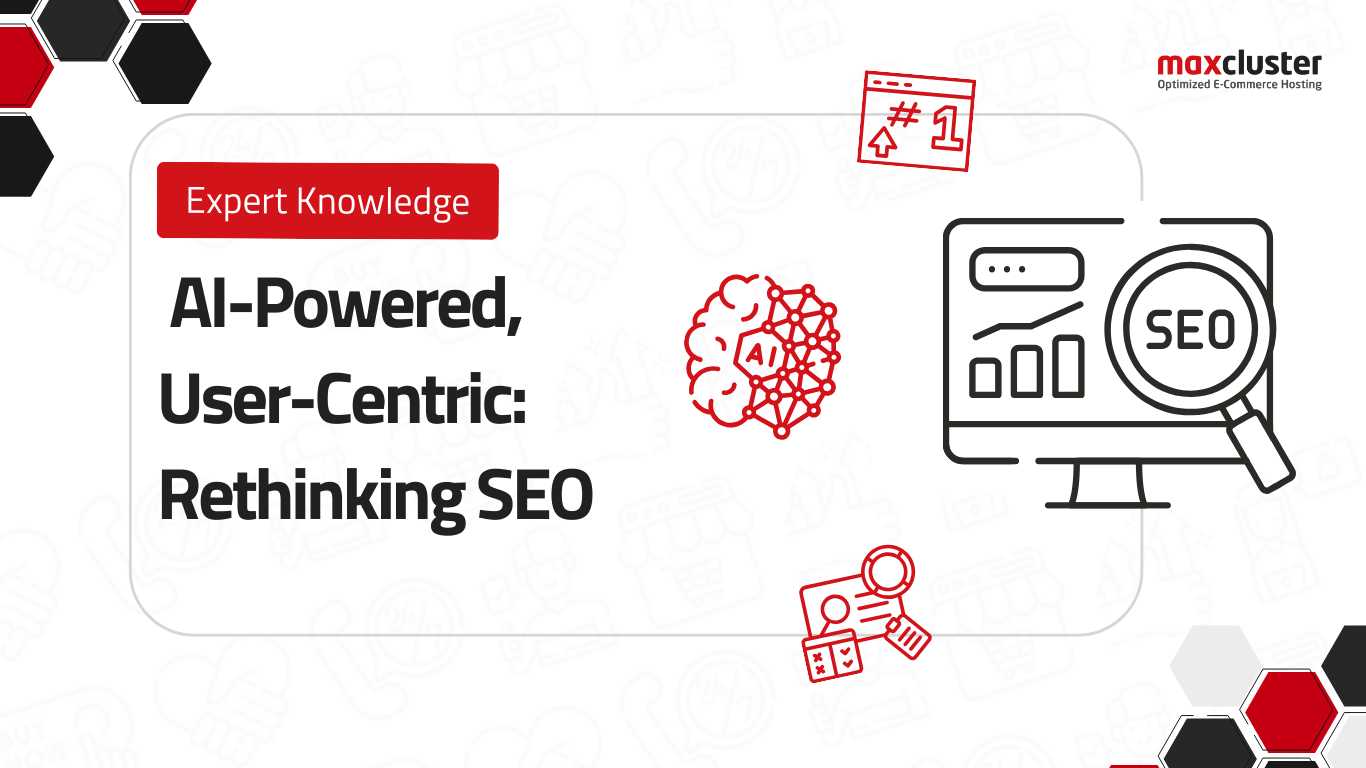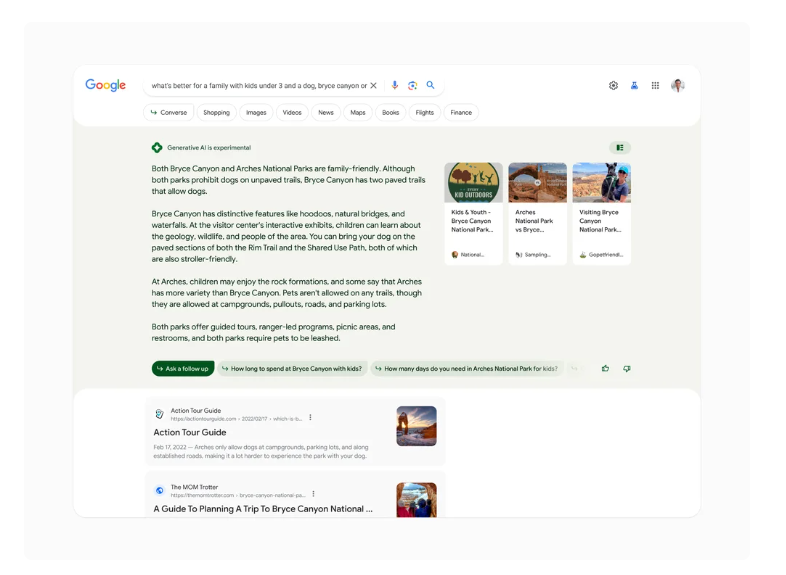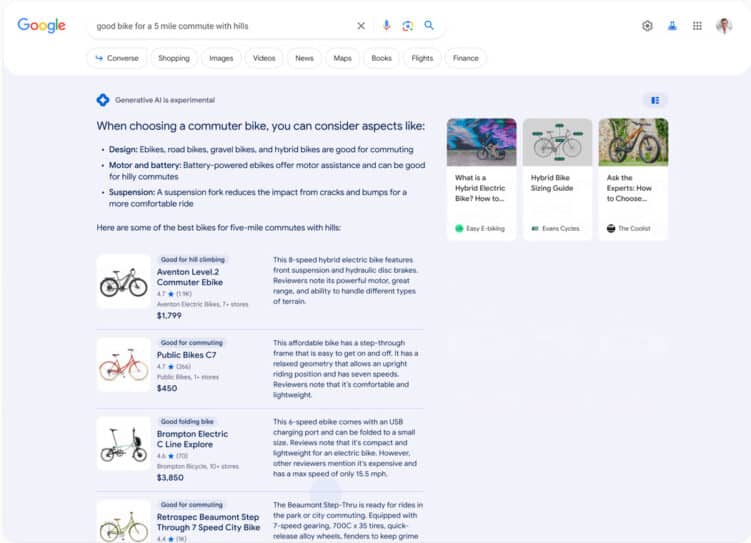
Your content is solid – but still not getting the visibility it deserves? In 2025, traditional SEO tactics are no longer enough. Without a clear focus on user experience, AI-readability, and technical performance, your site risks losing relevance – and valuable traffic.
This article breaks down what truly matters now – and how to future-proof your SEO strategy.
Core Web Vitals: When Technical Issues Kill Your Conversions
Google is increasingly evaluating websites based on real user experiences - and the focus is on core web vitals. Slow loading times, delayed responses and unstable layouts not only lead to a loss of ranking, but also directly affect the conversion rate.
A delay of just 1 to 3 seconds can increase the bounce rate by up to 32% (source: Think with Google). And according to Ahrefs, only around 33% of all websites meet the recommended Core Web Vitals values - an alarm signal with ranking and sales consequences (source: Ahrefs).
What exactly does Google measure?
The Core Web Vitals are central UX signals that Google uses directly for ranking:
| Key figure | Key figure | Target value |
|---|---|---|
| LCP (Largest Contentful Paint) | Loading time of the main content | < 2.5 sec |
| INP (Interaction to Next Paint) | Response time for interactions | < 200 ms |
| CLS (Cumulative Layout Shift) | Layout stability during loading | < 0,1 |
Technical deficits have a particularly strong impact on mobile - which immediately costs visibility and conversions (source: Google Search Central).
How to get your site in top form
Core Web Vitals are no longer purely technical metrics - they determine visibility and user retention. But how do you get the best out of your site?
1. Improve loading time (LCP)
Compress large media (WebP, AVIF), use lazy loading and a powerful CDN. Even more effective: the Speculation Rules API - this allows you to load content in advance and further reduce loading times.
2. Optimize response times (INP)
Reduce unnecessary JavaScript, load scripts asynchronously and prioritize interactive elements (e.g. buttons and forms) so that they respond immediately.
3. Ensure layout stability (CLS)
Use fixed sizes for images, videos and ads. Load fonts locally to avoid layout shifts.
Tools that help you:
| Tool | Use |
|---|---|
| PageSpeed Insights | Shows you how fast your page loads for real users - including tips on how you can improve this. |
| Lighthouse (Chrome DevTools) | Your SEO & performance check in the browser: Analyzes load time, accessibility, best practices - right at your fingertips. |
| WebPageTest | Detailed look under the hood: Analyze loading behavior, check waterfall charts, perform country or device comparisons. |
Hosting - the technical foundation of your SEO
Many optimization measures - from compressed images to lazy loading - only unfold their full effect if the hosting also plays along. Fast server response times, minimal downtime and a stable infrastructure are no longer just IT requirements, but real SEO factors.
High-performance hosting forms the basis for good core web vitals and ensures that your website remains stable and fast even during traffic peaks. Providers such as maxcluster offer an e-commerce infrastructure that is specially optimized for performance. This turns hosting from a potential risk factor into a real ranking advantage.
AI content & Search Generative Experience: When Google co-writes your content

Search Generative Experience: How AI is changing Google search results | Source: Google
With the introduction of the Search Generative Experience (SGE), the role of content in Google searches is changing fundamentally. Google is increasingly answering search queries directly on the SERP (Search Engine Results Page) - with AI-generated texts that are fed from trustworthy sources. The classic click on a website often does not occur - but visibility is created nonetheless.
What used to be handled by ten blue links is now handled by the so-called SBU box: automatically generated answer fields with compact texts, matching products, images and recommendations - directly in the search results.
For website operators, this means that content must not only be findable, but also structured in such a way that it can be understood and used by Google's AI. Visibility is increasingly created without a visit to the website - but it is precisely this presence that strengthens brand trust, relevance and, in the long term, market position.
How to make content SGE-fit
1. Write for humans - but structured for machines
Use subheadings in the form of questions to make it clear to Google what the respective section is about. The answer should follow directly afterwards - formulated in a compact, concrete and comprehensible way. Avoid unnecessary introductions or digressions. This way, the content can not only be read, but also used directly in SBU.
2. Increase the semantic depth
Instead of repeating keywords, develop content along meaningful topic clusters. Link related terms, use synonyms and create semantic context. Tools such as SurferSEO, Frase or NeuronWriter help you to identify connections and increase the depth of content in your texts.
3. Use structured data
Use targeted markups such as FAQ page or How-To to increase visibility in search results. Structured data helps Google to better understand your content and display it correctly. Use suitable markups depending on the content type:
| Inhaltstyp | Empfohlenes Schema-Markup |
|---|---|
| Häufige Fragen | FAQPage |
| Schritt-für-Schritt | HowTo |
| Redaktioneller Content | Article, Author |
| Produkte & Bilder | Product, ImageObject |
| Videos | VideoObject |
| Voice Search | Speakable |
Tools: Schema Markup Generator, Rich Results Test
4. Answer real user questions
Tools such as AnswerThePublic, AlsoAsked or the analysis of “People Also Ask” boxes help you to identify real search questions. Integrate these logically into your content - preferably as short, clearly structured question-answer blocks. This not only increases your chances of SGE, but also of classic featured snippets.
5. Use AI tools sensibly
GPT, Jasper and other AI tools are great helpers for collecting ideas, outlines or formulation suggestions. They can improve the structure and efficiency of your content production - but they are no substitute for a human perspective, specialist knowledge and real experience. Ideally, the final polish should always be done by a human.
Visual & multimodal search: When text alone is no longer enough

Visual and multimodal search: More than just words | Source: Canva
In 2025, classic text SEO is often no longer enough. More and more users are searching with images, screenshots or voice input. Google is responding with multimodal search - based on technologies such as Google Lens and the Multitask Unified Model (MUM), which understands and links content across text, images, video and audio.
An example: A user takes a photo of a sneaker and asks by voice: “Is this also available in waterproof?” - Google delivers suitable products, stores and reviews. To remain visible in such scenarios, you need content that is visually strong, technically optimized and semantically clearly integrated.
How to become visible in the visual & multimodal search
1. Use image SEO strategically
Images are much more than decorative elements - they influence rankings, visibility in Google Lens and even conversions. Pay attention to:
- Alt texts with naturally placed keywords
- Speaking file names such as hiking-backpack-blue.jpg
- Modern formats such as WebP or AVIF for better loading times
- Responsive images via srcset so that they look good on all devices
- Context: images should match the content of the surrounding text
Tools: TinyPNG, Squoosh, Screaming Frog (for alt tag checks), PageSpeed Insights
2. Video SEO as a must-have
According to Think with Google, 90% of users expect video content in product searches (source: Think with Google). Pay attention to your videos:
- Keyword-optimized titles and descriptions
- Transcripts & subtitles for accessibility and indexing
- Chapter markers so that users (and Google) can quickly grasp the content
- Attractive thumbnails that catch the eye and encourage clicks
Use specific platforms - YouTube, Vimeo or self-hosting - depending on the target group.
3. Combine Voice Search and Visual Search
Voice search and visual search often go hand in hand. Your content should therefore:
- Answer questions in a structured way - ideally in H2/H3 with <100 words answer directly below
- Use FAQ page or speakable markup
- Be clearly structured and easy to understand - no long nested sentences
EEAT 2.0: Trust is becoming the SEO currency

Why trust is the new SEO gold | Source: Canva
Today, search engines not only ask: What is being said - but above all: Who is saying it? With EEAT 2.0 (Experience, Expertise, Authoritativeness, Trust), the credibility of the website and author is becoming a ranking factor. Especially in times of AI content, the human factor is gaining in importance - across all industries.
What does EEAT mean - and what's new?
| Abbreviation | Meaning | What Google wants to know |
|---|---|---|
| E | Experience | Does the author have real, lived experience? |
| E | Expertise | Is sound specialist knowledge recognizable? |
| A | Authoritativeness | Is the source perceived as trustworthy? |
| T | Trust | Is the website secure, transparent, professional? |
New in 2025: EEAT has a stronger impact on rankings than ever before - not just indirectly via content, but directly via your brand perception, transparency and positioning.
Why this is crucial for your business
Specialized providers, B2B companies and niche stores in particular benefit. They can show their authenticity and proximity to the target group much better than anonymous mass content. Those who share real experiences and convince with expertise clearly stand out from generic AI communication.
How to strengthen your EEAT signals
1. Make your experience visible (Experience)
Show that there are real experiences behind your content - not just theory. For example, share:
- Practical examples from your team or everyday customer life
- Your own use cases, photos, quotes, internal processes
- Personal anecdotes that make your topic tangible
Example: “Our employee Anna tests every new collection on a 3-day tour in the Alps - only what convinces her makes it into the store.”
2. Underline specialist knowledge (expertise)
Expertise must be recognizable and comprehensible - for users and Google:
- Author profiles with photo, bio, qualifications and, if applicable, links to specialist articles
- Technical terms in the text - explained, not simply scattered around
- Quotes from experts, sources with year & author
Tip: Use structured data (author, article) so that Google can categorize your expertise in a machine-readable way.
3. Build authority in a targeted manner (authoritativeness)
Authority is not built overnight - but through consistent presence:
- Guest posts, interviews or podcast appearances
- Backlinks from renowned sites
- Mentions by partners or industry portals
Tools such as Ahrefs, Mention or BuzzSumo help to make authority signals visible.
4. Securing trust technically & editorially (Trust)
Trust is more than an SSL certificate - it is a combination of UX, transparency and credibility:
- GDPR-compliant legal notice, clear contact information, HTTPS
- Clear navigation, mobile-friendly & barrier-free design
- Customer reviews (e.g. via Trustpilot or ProvenExpert)
- No clickbait, empty promises or aggressive sales texts
Data-driven & automated: SEO strategies with a system
Effective SEO is no longer based on gut feeling. If you want to increase visibility and conversions, you need a clear database and structured processes. This is the only way to improve content in a targeted manner, identify weak points and exploit potential.
Modern tools can be used not only to analyze rankings and traffic, but also to identify user behavior, conversion barriers and untapped opportunities. If you understand where the problems are, you can optimize in a targeted manner - instead of acting on luck.
How to develop a data-driven SEO strategy
1. Content audit: What really brings results?
Not all content performs the same - and not every post deserves an update. A regular audit helps you to keep an overview and make targeted investments.
Important questions:
- Which pages achieve many impressions but hardly any clicks?
- Which posts are losing visibility?
- Which content could benefit from an update or a merge?
Helpful tools:
- Google Search Console: Performance data at URL level
- Screaming Frog: Technical & structural analysis
- SEMRush / Ahrefs: Keyword positions, backlinks, potential
- Looker Studio: Visualized dashboards for team & management
2. Understanding search intent & page type
Not all pages pursue the same goal - and should therefore be evaluated differently. It is crucial to know the appropriate metric for each page type.
| Page type | Target | Focus metrics |
|---|---|---|
| Category Page | Conversions | Click Depth, CTR, Cart Rate |
| Product Page | Trust & Performance | Load Time, Bounce Rate, Scroll Behavior |
| Guide / Blog | Information & Visibility | Dwell Time, Scroll Depth, Engagement Rates |
Tools such as Microsoft Clarity, Hotjar or Smartlook show you exactly how users move around your site, where they leave off - and what content really interests them.
3. Test snippets & meta data specifically
Many pages give away click potential through generic or unattractive snippets. Even small changes can significantly increase the CTR.
You can test, for example:
- Questions in the title: “How does ... work?”
- Numbers & emojis: “🚀 7 SEO tips for better rankings”
- Keyword positions: further forward = more visibility
- Meta descriptions with call-to-action or added value
Track the CTR development in the Search Console and optimize iteratively
4. Automate processes - with a sense of proportion
Today, modern SEO tools make it possible to automate many time-consuming tasks. But: quality, tonality and strategic decisions remain human.
What you can automate:
- Content briefings with tools such as Frase, SurferSEO or GPT
- SERP tracking & alerts via SEMrush, Ahrefs or Morningscore
- Analyze internal links with Screaming Frog + GPT plugin
- Snippet optimization with the help of AI-supported suggestions
The combination of automation and human control ensures efficiency without loss of quality.
SGE & Zero-Click: Visibility without a click - and still a win

Zero-Click &SGE: When Google gives the answer itself | Source: Google
More and more search queries end without a classic click. Google provides answers directly on the SERP - with SGE boxes, info panels, product recommendations or video clips. What used to seem like a loss of traffic is now a new opportunity: for visibility, trust and brand presence.
According to SparkToro, over 50% of all search queries were already click-free in 2022 (source: SparkToro). With the introduction of the Search Generative Experience (SGE), this proportion will continue to rise. Visibility does not disappear - it just changes its form.
Why zero-click visibility matters
Even without a website visit, your brand can score points - where users are actively searching:
- Brand awareness: You appear at the most relevant moment.
- Trust: Content in Google's answer boxes enjoys high credibility.
- Recognition: Those who have seen you once will remember you the next time they make a purchase decision.
How to become SGE- and zero-click-ready
1. Formulate answers clearly and compactly
Structure your content so that Google can easily pick it up:
- Use questions as subheadings (H2/H3)
- Give concise answers directly afterwards (under 100 words)
- Avoid empty phrases - focus on clarity and usefulness
2. Optimize for featured snippets
- Use lists, bullet points or tables
- Set keywords early in the paragraph
- Integrate relevant terms in subheadings
3. Use structured data in a targeted manner
Increase the chance of appearing in SBU boxes or rich snippets:
- FAQ page for frequently asked questions
- How-to for instructions
- Speakable for voice search
- Product, review, article for store or editorial content
4. Use multimedia context
SBU prefers content with multidimensionality:
- Videos with subtitles and transcripts
- Images with alt tags and semantic context
- Infographics with a clear description and thematic embedding
Conclusion
Search engine optimization 2025 is no longer a single discipline. If you want to be successful in the long term, you need to combine technology, content, trust and data strategies. It's no longer enough to just set keywords or hope for backlinks - what matters is how well your content can be understood, used and experienced.
SEO is becoming more technical - but also more human. Investing wisely now, optimizing processes and creating content with real relevance lays the foundation for a strong online presence - today and tomorrow.
Your SEO checklist 2025
Here is your condensed overview of all the to-dos from the article - for you or your team:
1. Core Web Vitals (technique)
- Compress images & videos (WebP/AVIF)
- Use lazy loading & CDN
- Minimize JavaScript
- Set fixed sizes for layouts
- Check PageSpeed Insights & Lighthouse regularly
2. AI & Search Generative Experience (content)
- Structure content in question-and-answer formats
- Semantic optimization with topic clusters
- Incorporate structured data such as FAQPage & HowTo
- Use GPT for briefings, but finalize them humanely
3. visual & multimodal search
- Use alt texts & descriptive file names
- Provide images & videos with structured data
- Add transcripts & chapters to videos
- Create voice-optimized content
4. EEAT 2.0 (Trust)
- Make author profiles visible with photo & bio
- Enrich content with practical knowledge & case studies
- Ensure HTTPS, clear navigation & mobile-friendliness
- Correctly link studies & specialist sources
5 Data & automation
- Perform content audit at least 2× per year
- A/B test meta data & snippets regularly
- Set up automated reporting for rankings & behavior
- Use tools such as GA4, Clarity, Frase & SEMrush effectively
6. zero-click & SGE optimization
- Write snippet content <100 words
- Target featured snippets & “People Also Ask” formats
- Use FAQ and How-to markup
- Integrate multimedia content & alt texts




